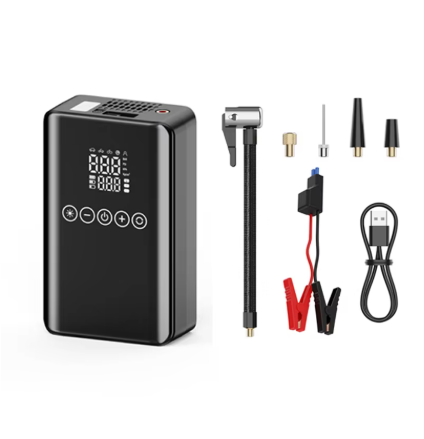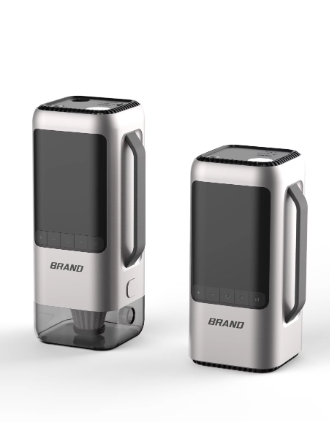אפשרויות מקור כוח לממתקי עיגון רכב
בחירת מקור הכוח הנכון משפיעה באופן משמעותי ממשת רכב יעילות. קיימות שתי מערכות דומיננטיות: יחידות 12V DC מחוברות דרך המחליק ברכב שלך, ומודלים ללא חוטים מבוססי סוללת ליתיום-יון שנועדו לפעולה חופשית.
12V DC מול מערכות סוללה ללא חוטים
יחידות של 12V DC מבטיחות אפס השבתה, כל עוד לרכב שלך יש ספק כוח להפעלת המנוע, הקולח יכול לפעול ללא הפסקה. עם זאת, הכבלים יוצרים הגבלות בתנועה ודורשים מהמשתמש להישאר קרוב לרכב. האפשרות ללא כבל הפכה לפופולרית ביותר כאשר מדובר בניידות, והיא נדסת במקשה ליתיום-יון קומפקטית (בערך 1500–7800mAh), מה שמאפשר למלא אוויר במרחק מהרכב – זוהי דרישה חיונית למשאיות או מצבים עמוסים בצד הדרך. קיימות פשרות בקצה הטמפרטורות הנמוכות: בעוד שמערכות של 12V ממשיכות לפעול גם בטמפרטורות מתחת לאפס, משך הפעלה של סוללות ליתיום יורד ב-20–40% בסביבה קפואה.
חיי בATTERY ויעילות טעינה
היעילות של יון-ליתיום תלויה גם בקיבולת וגם בטכנולוגיה. דירוגים גבוהים יותר במיליאמפר שעה (למשל 7800 מ"ש לעומת 2000 מ"ש) פירושם שניתן למלא אוויר ב4–2 צמיגי רכב גבוהים על ידי טעינה אחת, אך הם מוסיפים למשקל הכולל. תהליך הטעינה חשוב אף הוא, עם טעינה מהירה דרך USB-C מגיעים ל-80% מהסוללה תוך 60–90 דקות, בעוד שהחיבור הסטנדרטי micro-USB עשוי להימשך 3–5 שעות. בריאות הסוללה - לפי דוחות בתעשייה האוטומобильית, אובדן הבריאות של הסוללה החStored נעה בין 5–8% בחודש; לכן מומלץ להמליץ על טעינה מחדש אחת לרבעון אם הרכב נשמר לאורך השנה. דגמים מתקדמים כוללים גם מערכות קירור שמטרתן לשמור על טמפרטורת טעינה אופטימלית כדי למקסם את משך החיים של הסוללה.
פתרונות כוח היברידיים לגיוון
הניפוח ההיברידי מפחית את "חרדת הסוללה"; באמצעות שימוש ב-DC 12V בזמן שהרכב כבוי, הסוללות והמעבדים מוזנות בעת הניפוח. חלקם מגיעים עם יציאות חשמל לבית עבור בית ג garage וגם הופכים אותם ל펌פה רב-תכליתית. גמישות כזו היא שימושית במיוחד למקרי חירום ממושכים, וכן לעבודות הכוללות מספר כלי רכב. תוצאות סטטיסטיות מראות שהיברידים מפחיתים הפסקות במשימות ב-57%, בהשוואה לפתרונות беспроводית בלבד בסביבות מציאותיות של קומות מרובות. הרוב הם כבדים ב-10–30% מאשר חבילות סוללות רגילות, אך מספקים שלווה נפשית למסעות מיידיים.
עיצוב ניידות במונעי מילוי אוויר לרכב
גודל קטן ואופטימיזציה של המשקל
היום מונעי מילוי אוויר לרכב התמקדות בקומפקטיות ונוחות, עם דגמים מתקדמים ששוקלים פחות מ-3 קילו וממדיהם קטנים מאבק מים ממוצע. לדוגמה, בבדיקה של MotorTrend משנת 2024 ניתן למצוא יחידות אולטרא-קומפקטיות בממדים של 7.0 x 3.0 x 2.0 אינץ', מספיק קטנות כדי להיכנס לרוב קיטי החירום. איזון המשקל הוא קריטי – דגמים של Craftsman (12 וולט מקסימום) במשקל 1.3 ליבת: עם מינימום משקל שיגרום לעייפות פרק כף היד לאורך זמן שימוש, וכן מבנה איתן עם מסגרת פולימר מeger reinforced glass.
פתרונות אחסון להטמעה ברכב
מעצבים משתמשים בשלוש אסטרטגיות כדי לשפר את האחסון:
- מסוים לפי צורה מקרים איחוי צינורות/פיות
- ידיות מתכופפות להטמעה בארון היד
- מערכות רתימה מגנטיות לייצוב במחלקה האחורית
שקיות ניילון דו-שכבתיות (נמצאות ב-68% מהדגמים היוקרתיים) מגינות על הרכיבים מבלי להוסיף נפח, בעוד תיכנונים מודולריים מאפשרים למשתמשים לנתק את חבילות הסוללות לאחסון קומפקטי. מערכת ההגדמה הממוצעת תופסת כיום 40% פחות שטח בהשוואה לדגמים משנת 2019, בזכות סידור מיטוב של הרכיבים.
مقابض ארגונומיות ומאפייני תחבורה
מ graspים מרובי טקסטורה (קשיחות 85-90 Shore A) ומנשאבים מסתובבים מקילים על עמוד השדרה בכ-40% במהלך פעולות הגדמת צמיגים. דגמים מהשורה הראשונה כוללים:
- רצועות כתף ניתנות להימשכו עם ריפוד אנטי-חליקה
- جيب צד קלי גישה למبدل klepst
- הפצה מאוזנת של המשקל (נבדקה ביחס של פחות מ-0.8:1 בין קדימה לאחור)
מחקר הארגונומיה של Car and Driver משנת 2023 הראה כי מנשאבים בזווית משפרים את זרוע המנוף ב-22% בהשוואה לעיצובים ישרים. תיבת תחבורהทนנית לסערות מאפשרת התקנה יציבה על טבעות חגורת או קרסים ללא פגיעה בתנועה במהלך הפעלה.
פונקציית כיבוי אוטומטית בממליאי צמיגים
מדחס האוויר של הרכב, שיכבה אוטומטית, יפסיק לפעול באופן אוטומטי כאשר הוא מגיע לרמת הלחץ הרצויה שהגדרת, כך שאין צורך לדאוג עוד מלחץ אוויר נמוך או ניפוח יתר בצמיגים. פונקציה זו, המונעת על ידי מיקרו-מעבד, מווסתת באופן קבוע את הלחץ בעזרת חיישנים מובנים, יחד עם זמן תגובה מהיר של אלפיות השנייה לאחר הגעה לנקודות הקבועות. על ידי ביטול בדיקות ידניות לחלוטין, הם מונעים מצבים לא בטוחים כמו התפוצצויות או הפרדת שכבות הנגרמות עקב ניפוח יתר בצמיגים. נהגים חווים שליטה רבה יותר עם טכנולוגיות אלו ברכב, וכתוצאה מכך נסיעה יציבה יותר ובלימה משופרת; הם גם נהנים משקט נפשי בידיעה שהמערכת אמינה הרבה יותר מסוג "עיפרון" מסורתי כמו אלה שנמצאים ברוב חצרות בתי הספר, המספקים קריאות רגישות בתנאי שלג וקפוא.

בדיקות עצמאיות מבטיחות אמינות בפועל בכל תנאי עבודה. מומחי ניפוח עיקריים שמרו על סטייה של פחות מ-1.5 PSI לאורך מגוון דרכי ניפוח, לפי הערכות תעשייתיות (2023). הטכנולוגיה מתאימה לתחום יישומים רחב - ממכלולי אוויר לאופניים עם קיבולת 30 PSI ועד מכלולי אוויר למכוניות SUV עם קיבולת 50 PSI - ומבטלת את סיכני הניפוח החלשיות כמו בלאי מוקדם וחימום יתר. תחזוקה נכונה של הלחץ מבטיחה שימוש מיטבי בדלק על ידי הפחתת התנגדות גלגול. ננקטות אמצעי ביטחון כפולים למניעת הפעלה אקראית ומבטיחים שהמערכת תישאר armed גם אם היד שלך תיגע במנפח.
סטנדרטים לדיורabilidad עבור מדחסי רכב כבדים
בניה כבדה מפרידה בין מודלי מקשה מקצועיים לבין מודלי צרכן בסוג זה של סביבה אכזרית. כלים להגדלה חייבים להיות מעוצבים במיוחד לתעשייה 24/7 פעולה חוזרת, טמפרטורה (22-°F עד 158°F) ורטט עקבי. יוניטים המקיימים את סטנדרט ה-MIL-STD-810H נמצאו עם 40% פחות תקלות במהלך חמש שנים של יישום בשטח מאשר המודלים הרגילים. מודלים אמינים אלו בעלי פונקציה מלאה יכולים לעמוד בנוזלים אוטומוביליים, אבק דרכים וגובה עד 3,048 מטר.
מבנה מחומר מדרגת צבאית
הבנייה המפוארת חזקה בהרבה יותר, תוך שימוש באלומיניום תעשייתי ופולימרים מוגזים. רכיבים אלו עוברים מבחני מאמץ המשמשים לדימות תחבורה בתנאי קיצון עם מבחן סプレー מלח של 500 שעות ומבחני מחזור טמפרטורה בין 40-° פרנהייט ועד 230° פרנהייט. טכנולוגיית מאמצים כוללת חיבורים מברזל מחוזק וצינורות מפליז נержשת העשויים לעמוד בעומסי לחיצה של מעל 150 PSI. הנדסת המתכת הזו מונעת דליפת גז וקליקות, והפנייה המアナודיזציה מגבירה את ההתנגדות לשרף, במיוחד מול מי מלח. עמידות בכ-300% יותר לרעידות מנוע הודות שילוב מתקדם של פלסטיק מורכב וסיבים מחוזקים.
הגנה against מזג אוויר ועמידות בפני מ удар
מאפייני הגנה סביבתית מוגזמת כוללים חותם הגנה עם דירוג IP67 יחד עם מבנה מרוכב, ומספקים יתרון של טווח ארוך עם קיימנות לטווח רחוק. האלקטרוניקה המגוונת ממוקמת מתחת לפני השטח של המכשיר כדי להימנע מהצטברות מים וכלאים אחרים, והיא כלולה במנברן שمانעת חדירה כדי להתנגד לחדירת אבק. גוף מכסה עטוף בגומי ומבנה מגן בצורת משושה נגד התהפכות מגבירים את ההתנגדות לפגיעות מגובה 2 מטר. בדיקות במעבדה עצמאית אישרו שהיחידות הללו שומרות על דיוק קליברציה של ±0.5% PSI גם לאחר הלם תרמי השווה למעבר ממדבר להרים. הגזמה אסטרטגית מגינה על אזורי מפתח פגיעים במיוחד בעת התהפכות.
מפרט ביצועים עבור יעילות מדחסא רכב
קיבולת PSI ומהירות ניפוח
בעת בדיקת יעילות של מתקף אוויר לרכב, הגורמים החשובים ביותר הם טווח ה-PSI והמהירות التشغילתית. מתקפי אוויר ניידים ללא כבל באיכות גבוהה מספקים 150–160 PSI, מה שאומר שאפשר למלא במהירות אוויר לרכב פרטי (25–35 PSI בפחות מ-5 דקות) וגם לשמור על לחץ טוב ליישומים עם לחץ גבוה יותר כמו צמיגי משאיות או דאצ'יות. מבחנים מהתעשייה מראים שדגםי מתקף האוויר הטובים ביותר יכולים למלא צמיגים מ-0 עד 35 PSI עד 67% מהר יותר בהשוואה למתקף 12V בסיסי, כאשר חלק מהם מסוגלים לבצע הפרשת אוויר מלאה ומילוי מחדש בתוך 6–7 דקות. לשם השוואה, מתקפי אוויר מסורתיים נוטים להשקיע 15–20 דקות כדי לבצע את אותו הדבר. אני ממליץ להעדיף דגמים שמצליחים לשמור על ירידה של 20% במהירות בלחץ מלא כדי להבטיח ביצועים אחידים בכל פעם.
דיוק מד לחץ (+/- 1% סטייה)
לחץ אוויר מדויק בטרים הוא המפתח לבטחון הטרים, ולצורך כך נדרש מד לחץ אוויר. מדדי מדידה דיגיטליים Precise Digital Inflator מצטיינים בדיוק של ±0.5 PSI –– מדויקים פי 10 יותר מהמדדים המכאניקיים הטובים ביותר ומעל לכל התחרות, והחלק הטוב ביותר הוא שאין צורך לכייל אותם אף פעם! ההוספה של מדד דיגיטלי יוצרת הבדל משמעותי. (פרסומת) בעוד שמדדים אנלוגיים הם קשיחים יותר, לעתים קרובות יש להם סטייה של ±2–3 PSI –– די כדי לגרום למילוי יתר או חסר במזון קריר, כאשר לחץ האוויר בטרים יורד ב-PSI אחד על כל ירידה של 10°בפרנהייט. יש לחפש מערכות עם תפקידי כיול אוטומטיות שמתקנות את ההבדלים בגובה ובטמפרטורה בעת המילוי.
תאימות למספר טרים (אופניים ועד SUV)
מכוניות למילוי אוויר רב-תכליתיות מסוגלות להתמודד עם לחצים בין 10 PSI (אופני הרים) ועד 150 PSI (משאיות מסחריות) עם זרימת אוויר מותאמת. תכונות תאימות עיקריות כוללות:
| מטרי | צרכי אופניים | צרכי רכב גדול/SUV |
|---|---|---|
| סוגי נווזלים | 3+ (Presta, Schrader) | 2+ מקלטים מחוזקים |
| אורך חבל | 12–16" | 18–24" |
| מחזור עבודה | 10–15 דקות | 25+ דקות |
92% מהמשתמשים בסקרים של 2024 דיווחו על הצלחה בשימוש בתנאי שימוש ברכב כאשר מתקעים מספקים נiples דו-מטרתיים וזמן ריצה רציף של 20+ דקות. יחידות עם חיישנים לחום המופנים תואמים עמידה ממושכת על ידי מניעת מאמץ של המנוע במהלך ניפוח ממושך במריחות או טריילרים.
שאלות נפוצות: מתקני ניפוח לרכב
מה ההבדל בין מתקף 12V DC למתקן ניפוח ללא חוטים?
מתקן ניפוח 12V DC סולק את הכוח מהמנורת הסיגריות של הרכב, ומאפשר פעולה רציפה כל עוד הרכב פועל. מתקני ניפוח ללא חוטים מציעים ניידות על ידי הפעלה באמצעות סוללות ליתיום-יון, אך משך הזמן בו הם פועלים יורד באופן משמעותי בטמפרטורות קרות.
האם ניתן להשתמש במתקני ניפוח ניידים בכל סוגי האופניים?
כן, מתקני ניפוח ניידים יכולים להתמודד עם טווח רחב של לחצי אוויר באופניים, החל מאופני הרים ועד אוטובוסים/SUVs, כל עוד יש להם סוגים מתאימים של נiples ומחזור עבודה מספק.
האם פונקציה של כיבוי אוטומטי חשובה במתקני ניפוח לרכב?
הכיבוי האוטומטי הוא קריטי מכיוון שהוא מונע הinchת יתר ומבטיח רמות לחץ אוויר בטוחות. הוא משתמש בсенסורים מובנים כדי לשלוט ולעצור את ההinchה בנקודות לחץ קבועות מראש.
האם מדחסי אוויר לרכב עמידים במזג אוויר ובמ удар?
רבים מהמדחסים באיכות גבוהה לתא המנוע נועדו להיות עמידים בפני מזג האוויר וכנגד הלמות, עם סגילים הגנתיים בדרגת IP67 וחומרים מחזקיםทนתיים כדי לעמוד בתנאים קשים.

